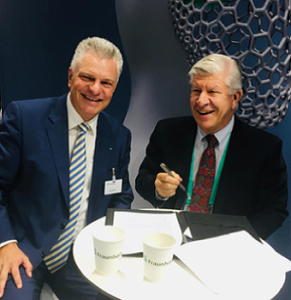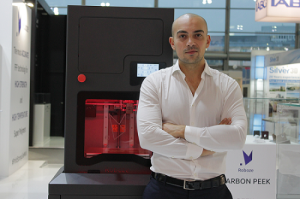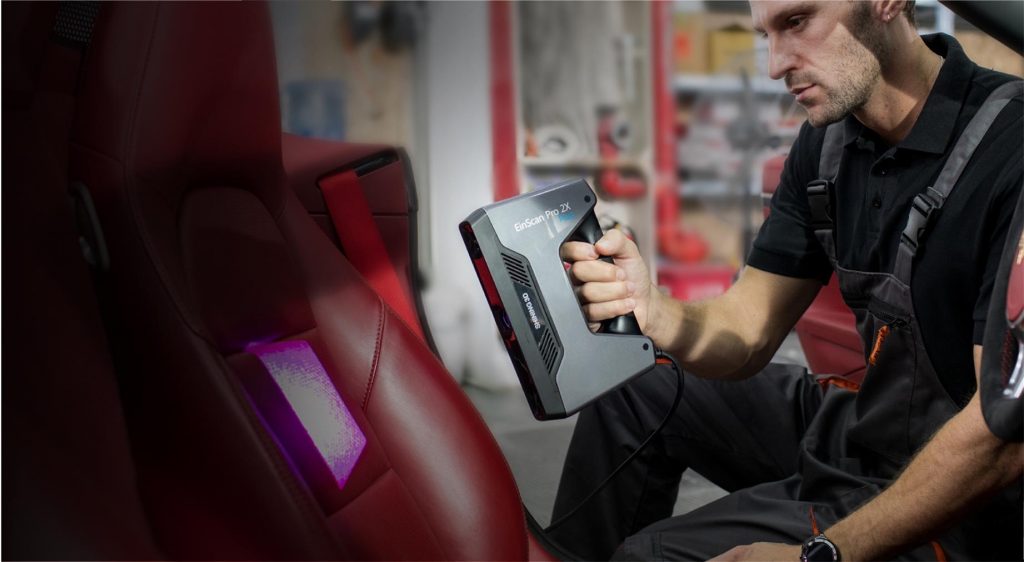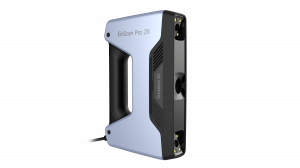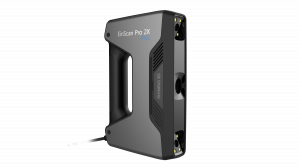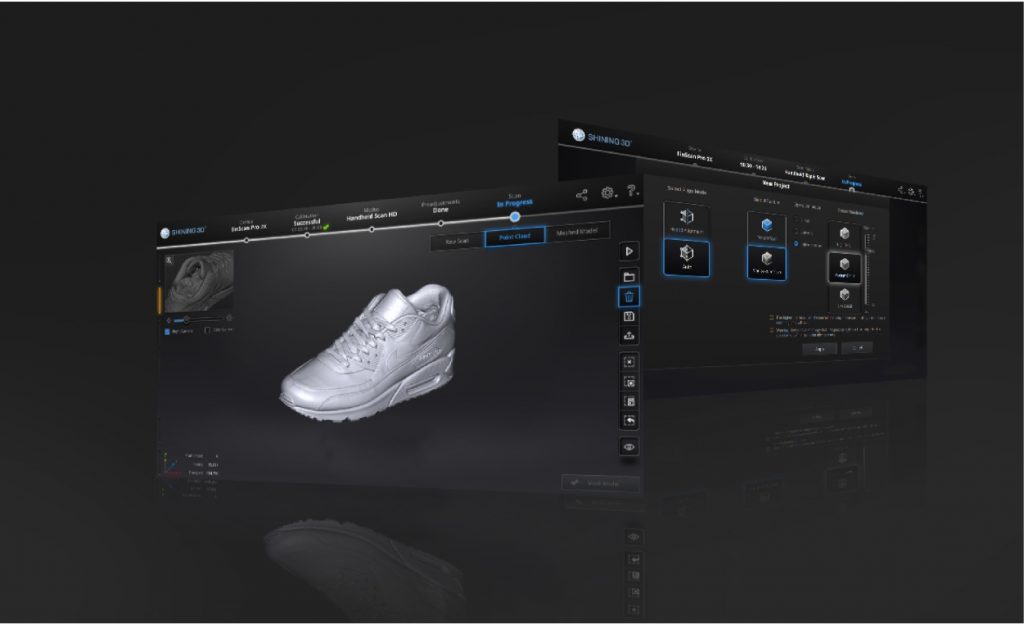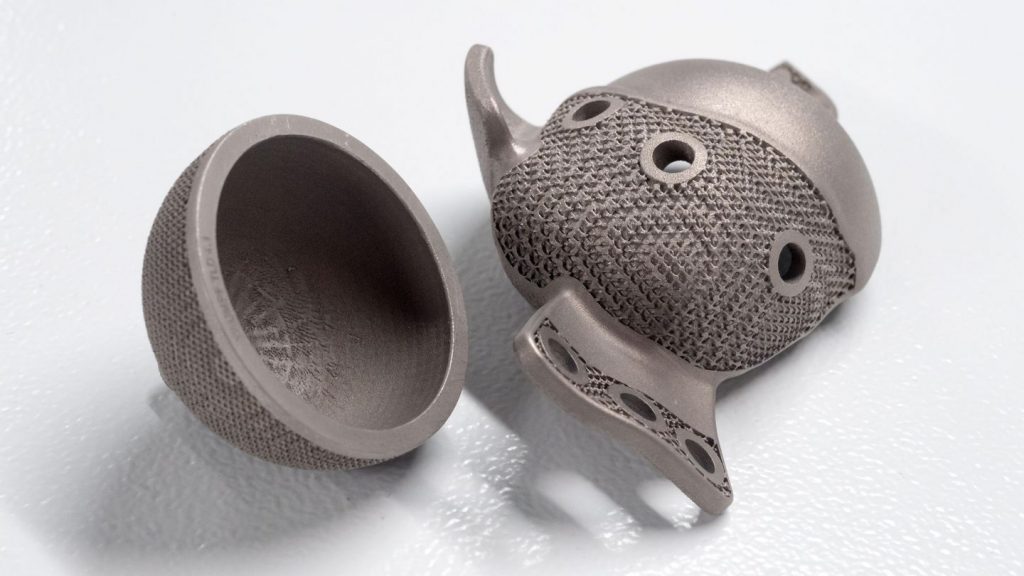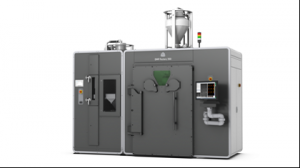3D Printing News Briefs: December 4, 2018
We’re sharing stories about events, business, and metal 3D printing in today’s 3D Printing News Briefs. To start, the second annual Iran 3DShow is coming up, along with IQPC’s fifth Additive Manufacturing for Aerospace & Space event in London. Moving on to business, Carbon has an announcement about a new executive, Sigma Labs has joined an R&D collaboration with Fraunhofer IAPT, and Xometry is now offering instant quotes on parts 3D printed with HP’s Multi Jet Fusion technology. Finally, Markforged is presenting a closer look at the process behind the Metal X.
Second Annual Iran 3DShow
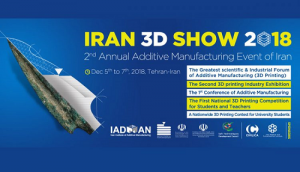 Last year, the country of Iran hosted its first 3D printing trade show, originally called the Additive Manufacturing Symposium before the name was changed to Iran 3D Show. Now, the country is gearing up for the second annual event, which will be held at the Book Garden in Tehran from December 5-7. The Vice-Presidency for Science and Technology of Iran is holding the event, with the Iran Institute of Additive Manufacturing acting as the execution team and organizer. There will be a 3D printing competition for teachers and students, and the trade show itself is made up of three additional sub-events, called “The 2nd Exhibition of 3D Printing Industry.”
Last year, the country of Iran hosted its first 3D printing trade show, originally called the Additive Manufacturing Symposium before the name was changed to Iran 3D Show. Now, the country is gearing up for the second annual event, which will be held at the Book Garden in Tehran from December 5-7. The Vice-Presidency for Science and Technology of Iran is holding the event, with the Iran Institute of Additive Manufacturing acting as the execution team and organizer. There will be a 3D printing competition for teachers and students, and the trade show itself is made up of three additional sub-events, called “The 2nd Exhibition of 3D Printing Industry.”
“This event is not only good for the ones who are trying to observe the market here, but also suits the international companies to join and involve,” said Seyyed Amir Ghaffari, the Managing Director of Iran 3D Show.
Fifth Additive Manufacturing for Aerospace & Space
 Aligned to support the UK’s national AM strategy, the fifth Additive Manufacturing for Aerospace and Space conference by IQPC will be held in London from February 26-28, 2019; last year the forum was hosted in Munich. The conference helps attendees take on the roadblocks to adopting 3D printing and other industrial digitalization practices. The event provides content that helps 3D printing users exploit economic returns and performance gains provided by the technology. In addition, Airbus will be hosting a visit to its nearby Space Systems facility during the conference.
Aligned to support the UK’s national AM strategy, the fifth Additive Manufacturing for Aerospace and Space conference by IQPC will be held in London from February 26-28, 2019; last year the forum was hosted in Munich. The conference helps attendees take on the roadblocks to adopting 3D printing and other industrial digitalization practices. The event provides content that helps 3D printing users exploit economic returns and performance gains provided by the technology. In addition, Airbus will be hosting a visit to its nearby Space Systems facility during the conference.
“Now entering its 5th year, the conference has fast established itself as the premium forum for AM users, R&D experts and industry partners within the aerospace and space industry,” Olivia Timmins, Senior Marketing Manager for IQPC, told 3DPrint.com. “This year is no different with expert speaker line up from Thales, MTC, ESA, Airbus, Safran and more.”
If you register by Saturday, December 15th, you can even save up to £300 of the total cost.
Carbon Announces New Company Executive
Silicon Valley-based Carbon has announced a new executive, as Dara Treseder joins the company as the Chief Marketing Officer (CMO). The former CMO for GE Business Innovations and GE Ventures, Treseder is charged with finding new ways to showcase the company’s story at scale; with her excellent record, this should not be too challenging. This year, Treseder, who is also the co-founder of consulting firm NeuBridges, was featured by Forbes as a CMO Next, and in 2017, she was recognized on AdAge as one of the Women to Watch and by Inc. as one of the 30 Inspirational Women to Watch in Tech. Additionally, she is a sought-after speaker and writer on many subjects, including marketing, growth, innovation, and creating more diverse workplaces.
“I am deeply inspired by Carbon’s vision and values and excited to be part of a trailblazing team that is redefining digital manufacturing and creating the industry’s future. As chief marketing officer, I am looking forward to advancing Carbon’s brand, strengthening our customer connections, and rapidly scaling our global growth,” Treseder said.
Treseder is coming on board as Carbon works to strengthen its leadership team, and will support the growing company’s mission to keep driving the manufacturing industry’s digital transformation.
Sigma Labs Partners with Fraunhofer IAPT
This week, the Fraunhofer Research Institution for Additive Manufacturing Technologies (IAPT) and Sigma Labs, Inc., which provides quality assurance software under the PrintRite3D brand, announced a new collaborative research and development agreement that will focus on the industrialization of additive manufacturing. At last month’s formnext 2018 in Germany, John Rice, the CEO of Sigma Labs, and Prof. Dr.-Ing. Claus Emmelmann, the Managing Director of Fraunhofer IAPT, signed the joint agreement. As part of the agreement between the two, Sigma Labs will be upgrading Fraunhofer IAPT’s current PrintRite3D system.
“The aim of this collaboration is to test and validate the use of the PrintRite3D system to identify and quantify machine and process inconsistencies as well as flag defect thermal signatures during the laser melting process, and correlate them to CT scan results. Ultimately, this will allow users to reduce scrap, increase productivity and reduce post-process inspection costs,” said Rice.
Xometry Offering Instant Quotes on Multi Jet Fusion Parts
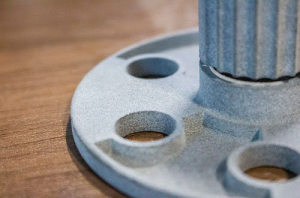 On-demand manufacturing platform Xometry has only been in business for five years, but it is releasing news at a fast clip. This summer, the company also introduced a new version of its Instant Quoting Engine, which included several new and enhanced features to offer customers instant quotes for CNC machining, sheet metal fabrication, urethane casting, and several 3D printing processes, including SLS, FDM, PolyJet, and DMLS.
On-demand manufacturing platform Xometry has only been in business for five years, but it is releasing news at a fast clip. This summer, the company also introduced a new version of its Instant Quoting Engine, which included several new and enhanced features to offer customers instant quotes for CNC machining, sheet metal fabrication, urethane casting, and several 3D printing processes, including SLS, FDM, PolyJet, and DMLS.
Now, Xometry has announced that it will be offering instant quotes on custom parts made with HP’s fast Multi Jet Fusion technology. As always, simply drag and drop your 3D models into the Instant Quoting Engine, select your process and materials (if you so choose), and Xometry will do the rest, analyzing the model’s geometry and providing an instant price, design feedback, and delivery date.
Markforged Metal X 3D Printer Process
 Last winter at CES 2017, Markforged introduced its Metal X, which is the company’s first 3D printer to leverage its Atomic Diffusion Additive Manufacturing, or ADAM, metal 3D printing technology. This spring, Markforged began shipping the Metal X to customers and resellers, and announced early last month that it had shipped over 100 machines, with an expectation of doubling that number by the end of 2018.
Last winter at CES 2017, Markforged introduced its Metal X, which is the company’s first 3D printer to leverage its Atomic Diffusion Additive Manufacturing, or ADAM, metal 3D printing technology. This spring, Markforged began shipping the Metal X to customers and resellers, and announced early last month that it had shipped over 100 machines, with an expectation of doubling that number by the end of 2018.
As we get closer to the end of the year, and Markforged works to achieve this goal, the company is giving the world a closer look at the innovative process behind its Metal X, with the publication of a time-lapse video on YouTube that shows all seven steps of the process, starting with the actual 3D printing of a part, removing and washing it, and ending with part manipulation, in less than two minutes. Take a look at the video below to see it for yourself:
Discuss these stories and other 3D printing topics at 3DPrintBoard.com or share your thoughts in the Facebook comments below.
3D Printing News Briefs: November 23, 2018
We’re starting with a little business news in today’s 3D Printing News Briefs – Intech confirmed its first order for Additive Industries’ MetalFAB1 3D printer, and Roboze CEO Alessio Lorusso has won a prestigious Ernst & Young award. Moving on, researchers are working on 3D printable thermoelectric materials that can convert heat from the surrounding environment and convert it into electricity, while an architecture studio has developed a unique concept for a 3D printed, transportable toilet that converts something very different into electricity. Finally, if you’re looking for a unique gift this holiday season, check out Bloomingdale’s, which is working with Twindom and KODAK to offer 3D printed holiday portraits.
Intech Confirms MetalFAB1 Order with Additive Industries
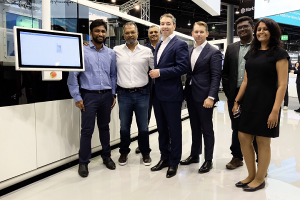 On the last day of formnext 2018, Bangalore-based Intech, a leader in metal 3D printing in India, confirmed its first order of the MetalFAB1 system from Dutch 3D printer manufacturer Additive Industries. This order marks Additive Industries’ expansion into Asia, and will also help Intech accelerate its business. Application and process development and customer support will be handled from the new regional Additive Industries center in Singapore.
On the last day of formnext 2018, Bangalore-based Intech, a leader in metal 3D printing in India, confirmed its first order of the MetalFAB1 system from Dutch 3D printer manufacturer Additive Industries. This order marks Additive Industries’ expansion into Asia, and will also help Intech accelerate its business. Application and process development and customer support will be handled from the new regional Additive Industries center in Singapore.
“Accelerating adoption of additive manufacturing is the primary objective at Intech. Moving from prototyping to series production with focus on cost per part with repeatable quality is the way forward. This is a stepping stone for Intech in achieving its goal to meet the demands of customer requirements of printing large parts with excellent quality,” explained Sridhar Balaram, the CEO of Intech. “Intech has been working with various customers in different industry verticals by identifying parts for mass production as a proof of concept. With Additive Industries’ MetalFAB1 we can now scale for volume. The system is unique in the industry and we are excited to add this to our fleet of equipment.”
Roboze CEO Alessio Lorusso Wins Award from Ernst & Young
Alessio Lorusso, the CEO and founder of Italian 3D printing company Roboze, was recently awarded the prestigious 2018 Startup Award by Ernst & Young (EY) at its Entrepreneur Of the Year 2018 awards. Established for the first time during the 2015 awards, the Startup Award is awarded for contributing to a major growth of the Italian, and worldwide, economy, and is dedicated to an individual’s ability to create value with a spirit of innovation and a strategic vision. The award aims to make young, bright minds, who create a company from an innovative idea, more visible.
“In 2015, when we presented our first solution to the global market, I could not even imagine to achieve our goals in such a short time. We faced the logics of the machines design for additive manufacturing with clear, real and innovative competitive advantages. The market chooses us because our technology is definitely the best one, as specifically designed and produced to meet the real needs of the manufacturing companies,” said Lorusso. “This award is the result of the entire Roboze team’s hard work and constant commitment; so I want to dedicate this to each member of it. It was hard but we always believed it and this award does confirm that we are following the right way to conquer and revolutionize the whole global market.”
Thermoelectric Materials Converting Heat into Electricity
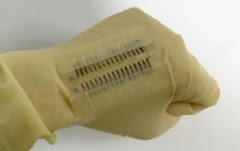
Flexible thermoelectric device embedded in a glove for generating electricity by body heat. [mage: Dr. Song Yun Cho, Korea Research Institute of Chemical Technology]
According to a review of new research in the Science and Technology of Advanced Materials journal, a team of scientists are working to design thermoelectric materials that can harvest heat from the environment, then convert it into electricity in order to power appliances and devices. Products made with these materials, such as wearable devices, could be more cost-effective, as they won’t need to recharge, change, or dispose of batteries. The team, which published a paper called “Thermoelectric materials and applications for energy harvesting power generation,” is investigating three different types of conducting materials, including inorganic and organic.
The abstract reads, “Thermoelectrics, in particular solid-state conversion of heat to electricity, is expected to be a key energy harvesting technology to power ubiquitous sensors and wearable devices in the future. A comprehensive review is given on the principles and advances in the development of thermoelectric materials suitable for energy harvesting power generation, ranging from organic and hybrid organic–inorganic to inorganic materials. Examples of design and applications are also presented.”
Most organic thermoelectric devices involve polymers, and semiconducting ones are more lightweight and inexpensive, can hold heat better than conventional inorganic semiconductors, and are flexible enough to be 3D printed. Inorganic thermoelectric devices can convert heat into electricity, but aren’t that flexible. The researchers say that while thermoelectric devices could actually replace traditional batteries in many applications someday, a lot more work is required first. Time will only tell with this one.
Spark’s 3D Printed Toilet
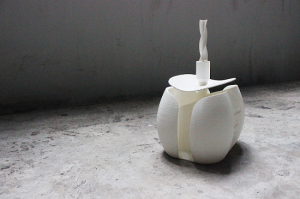 Speaking of electricity, architecture studio Spark has developed an innovative concept for a transportable toilet, made with 3D printed elements, that can actually convert human waste into electricity. Fittingly, the studio launched its Big Arse Toilet on Monday to coincide with World Toilet Day. The module was designed for use in remote villages in India, where the UN is working hard to tackle the sanitation and hygiene issues stemming from open defecation. The toilet elements would be 3D printed from bamboo fibers mixed with biopolymer resin, and the completed module would be anchored to a 3D printed reinterpretation of a traditional biogas dome buried underground, which uses waste to generate and store gas.
Speaking of electricity, architecture studio Spark has developed an innovative concept for a transportable toilet, made with 3D printed elements, that can actually convert human waste into electricity. Fittingly, the studio launched its Big Arse Toilet on Monday to coincide with World Toilet Day. The module was designed for use in remote villages in India, where the UN is working hard to tackle the sanitation and hygiene issues stemming from open defecation. The toilet elements would be 3D printed from bamboo fibers mixed with biopolymer resin, and the completed module would be anchored to a 3D printed reinterpretation of a traditional biogas dome buried underground, which uses waste to generate and store gas.
Spark told Dezeen, “The Big Arse toilet reinterprets the use and organisation of traditional bio-gas domes to create electricity and gas for those communities that have no access to power networks and utility infrastructure that we take for granted.
“Bio-gas is a product of the breakdown of organic matter, in the case of the Big Arse Toilet the biogas is a product of human waste, food waste and agricultural waste. The biogas can be used directly for activities such as cooking or can be used to drive a micro CHP turbine that converts the gas into electricity.”
Bloomingdale’s Offering Personalized Holiday 3D Printed Portraits
 3D body scanning leader Twindom, a brand licensee of Kodak, is offering a unique gift promotion this holiday season to shoppers at the Bloomingdale’s stores in San Francisco and New York City: personalized, 3D printed holiday portraits, made with the KODAK Full Body 3D Scanner until the end of December, just in time for Christmas. Shoppers who want to have a 3D printed portrait made can either make an appointment or just walk in to the store.
3D body scanning leader Twindom, a brand licensee of Kodak, is offering a unique gift promotion this holiday season to shoppers at the Bloomingdale’s stores in San Francisco and New York City: personalized, 3D printed holiday portraits, made with the KODAK Full Body 3D Scanner until the end of December, just in time for Christmas. Shoppers who want to have a 3D printed portrait made can either make an appointment or just walk in to the store.
Once there, simply enter your information, walk into the KODAK Full Body 3D Scanner, and pose for the scan, which only takes 1⁄4 of a second to complete. Then, review the 3D capture, choose your size – 3 to 14 inches – and place your order, which will be 3D printed in full color and ship in about 1-2 weeks. Pricing starts at around $69 for the 3D printed portraits, and local support at each store location is provided by Twindom’s local partners: PocketMe, PeoplePrints 3D, and Memories in 3D.
Discuss these stories and other 3D printing topics at 3DPrintBoard.com or share your thoughts in the Facebook comments below.
Shining 3D Introduces New Software and New 3D Scanning Possibilities with EinScan Pro 2X and EinScan Pro 2X Plus
At formnext last week, Shining 3D was among the companies unveiling new products to the world. The EinScan-Pro has been one of Shining 3D’s most popular products ever since it was introduced nearly three years ago, and it was followed up last year by the EinScan-Pro+. Now the company is extending its line of handheld 3D scanners further with the EinScan Pro 2X and 2X Plus.
“Based on the feedback received from thousands of users and the valuable input of SHINING 3D’s own R&D team, the EinScan Pro 2X & 2X Plus deliver substantial improvements on scan speed, accuracy and function,” said Oscar Meza, VP of Global Sales at SHINING 3D. “Making a dramatic breakthrough in scanning speed and data quality, the EinScan Pro 2X series is aimed to improve the efficiency in generating high-quality 3D models.”
3D scanners have come a long way from the large, unwieldy contraptions they used to be, and Shining 3D has been one of the companies at the forefront of truly portable scanners. The EinScan Pro 2X and 2X Plus are especially lightweight and compact, making for easy travel as well as plug-and-play installation. The two new scanners also offer faster scanning than their already speedy predecessors, processing up to 1,500,000 points per second (30 fps) under Handheld Rapid Scan Mode. They also boast high accuracy – single scan accuracy in Fixed Scan Mode is up to 0.04 mm. When using markers, the volumetric accuracy under handheld scanning modes is up to 0.05+0.3 mm/m.
 The EinScan Pro 2X and 2X Plus are capable of capturing fine details. Under Handheld Rapid Scan and Handheld HD Scan modes, the minimum point distance is up to 0.02 mm, allowing for high-resolution data. Both scanners have multiple modes of operation, including Handheld Rapid Scan, Handheld HD Scan, Fixed Scan with turntable and Fixed Scan without turntable. They offer several alignment modes as well, including feature alignment, markers alignment, turntable coded targets alignment and manual alignment.
The EinScan Pro 2X and 2X Plus are capable of capturing fine details. Under Handheld Rapid Scan and Handheld HD Scan modes, the minimum point distance is up to 0.02 mm, allowing for high-resolution data. Both scanners have multiple modes of operation, including Handheld Rapid Scan, Handheld HD Scan, Fixed Scan with turntable and Fixed Scan without turntable. They offer several alignment modes as well, including feature alignment, markers alignment, turntable coded targets alignment and manual alignment.
In addition, the EinScan Pro 2X and 2X Plus offer several optional add-ons, like the Color Pack, Industrial Pack and HD Prime Pack for multiple scanning applications.
The new 3D scanners were not the only products Shining 3D introduced last week; the company also has new software to offer. The EXScan Pro software features a brand new user interface and work flow that is easy to use regardless of experience level – it’s as easy as taking a video, according to Shining 3D. A new operation mode allows for a faster scanning experience during operation; users can then set the resolution option later during data processing. The software is compatible with several file types including STL, OBJ, PLY, ASC, P3 and 3MF.
Also now available is Solid Edge Shining 3D Edition software, the product of a collaboration between Siemens PLM Software and Shining 3D. It includes reverse engineering, generative design and simulation along with CAD tools in a single platform.
“The integration of Solid Edge SHINING 3D Edition, EinScan 3D scanners and 3D printer enables users a complete solution covering 3D digitize – design & simulate –additive manufacturing,” said Meza. “It will significantly improve the efficiency and quality for designers, engineers and researchers.”
Discuss this and other 3D printing topics at 3DPrintBoard.com or share your thoughts below.
DuPont debuts industrial carbon and glass-reinforced 3D printing filaments at Formnext
Crack-Free 3D Printing of Steel, Copper and More Made Possible with TRUMPF’s TruPrint 5000
At formnext, which took place in Frankfurt, Germany last week, several 3D printers were unveiled or premiered. One of the printers seeing its world premiere was TRUMPF’s TruPrint 5000, designed to 3D print numerous metals including high-carbon steel and titanium alloys without cracking or warping. The 3D printer is pre-heated to 500°C to accommodate the challenging metals.
“Tool and mold makers can now easily print forming tools, punches and dies. Previously, without preheating, that wasn’t possible,” said Tobias Baur, TRUMPF General Manager Additive Manufacturing with responsibility for technology.
The TruPrint 5000 also features a new green laser with a pulse function, which allows for the 3D printing of pure copper and precious metals.
“This makes it attractive for use in mechanical and plant engineering, as pure copper can be used to print particularly conductive inductors and heat exchangers,” continued Baur.
The 3D printer should also hold some appeal for the jewelry industry, as the green laser enables the 3D printing of individual unique gold pieces on demand. It doesn’t waste expensive gold or silver, making it more economical than milling or casting, which involves a loss of material.
Certain tool steels favored by tool and mold makers could not previously be 3D printed because they would crack during the printing process.
“The laser beam melts the component surface, which subsequently cools back down to room temperature,” explained Baur. “The components weren’t able to withstand this temperature drop, and cracks formed.”
The preheating function of the TruPrint 5000, however, lessens the temperature drop following laser melting.
“The material quality and surface of carbon steels are significantly better than without preheating, preventing fractures in the components,” said Baur.
In addition to tooling, the TruPrint 5000 is also well-suited for the 3D printing of prosthetic devices and implants.
“When the ambient temperature drops too sharply, the parts warp and we have to rework them,” said Baur. “In addition, we often require support structures that are difficult to set up and take down.”
Because the preheating function of the TruPrint 5000 reduces stresses, it not only improves processing quality but also frequently eliminates the need for support structures at all. In addition, it often reduces the need for downstream heat treatment, as well as making the titanium more resilient and the implants more durable.
To achieve the 3D printing of copper and precious metals using the green laser, the TruPrint 5000’s developers connected the new TruDisk 1020 disk laser with the TruPrint 1000 3D printer.
“Conventional systems use an infrared laser as the beam source, but its wavelength is too long and it can’t weld highly reflective materials such as copper and gold. This can be done with laser light in the green wavelength spectrum,” said Thomas Fehn, TRUMPF General Manager Additive Manufacturing with responsibility for sales.
Fehn predicts that this will open up new applications for 3D printing, such as in the electronics and automotive industries.
You can learn more about the TRUMPF TruPrint 5000 or request a quote here.
Discuss this and other 3D printing topics at 3DPrintBoard.com or share your thoughts below.
[Source/Images: TRUMPF]
Belgian Startup Introduces Flexible, Transportable, Large-Scale Colossus 3D Printer at formnext
This year’s formnext wrapped up last week in Frankfurt, and many companies were there to showcase their latest products, including Colossus, a multinational 3D printing startup based in Belgium. At the trade fair, the startup introduced its aptly named Colossus 3D printer, which it calls the largest and first fully integrated transportable 3D printer in the world. The Colossus was built with flexibility in mind – it’s easy to add on features and upgrade it, and the transportable 3D printer works as a fixed unit as well.
Yannick Aerts, CTO of Colossus, said, “We wanted to build a printing system that really adjusts to our customer needs, so making it as transportable and upgradeable as possible was a main priority.”
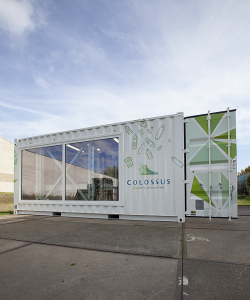 Everything on the Colossus, from extruder output and screw types to heated bed, software add-ons, and print volume, is configurable, which makes the system a good fit for a wide variety of industry applications.
Everything on the Colossus, from extruder output and screw types to heated bed, software add-ons, and print volume, is configurable, which makes the system a good fit for a wide variety of industry applications.
The Colossus, with a 4 m³ build volume, is able to support impressively fast print speeds of up to 15 kg an hour, and was designed with what the startup says is “a special accent on materials for furniture, construction applications and large size 3D objects.”
Thanks to the startup’s partnership with the Mitsubishi Chemical Corporation (MCC), ten material compound profiles have been pre-tested on the Colossus, and it’s the first 3D printer of its scale to print with rPET and rPP profiles. Additionally, it can also print with recycled plastic materials.
“Young designers often lack partners to realize their ideas due to the high entry barriers in this market,” said Philippe Mérillet, the Co-Founder of Colossus. “Clients also requested a way to make furniture and other large-scale objects from plastic waste, so we searched the market and a large-scale printer and everything we found was either too slow, too expensive, or could not work with high-temperature materials like rPET or CarbonP which are difficult to extrude. So we decided to develop a printer that would do just that a made for materials.”
After research showed that these kinds of massive, cost-effective 3D printers just aren’t readily available, Colossus had a vision to make a cost-effective, fast 3D printing platform that could also provide a second life to plastic waste. The 2.67 x 1 x 1.5 m Colossus 3D printer features a 3200 x 1300 mm liquid heated bed for easy print removal, along with a granulate-fed extruder print head and a dehumidification unit for achieving better print quality.
“Half of the quality of a print is the state of the material which is why we have a fully integrated drying unit to prep your material so you can get the most out of your print,” Colossus wrote in a release. “Capable of temperatures of up to 400C gives you the flexibility to print almost any plastic material.”
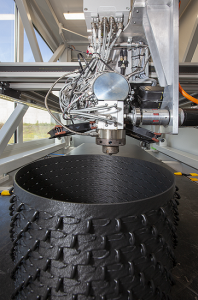 The Colossus 3D printer comes with logging software, in addition to remote connectivity and internet debugging with data points and cameras, so problems can be solved and upgrades can be completed remotely in real-time. The startup provides training, along with contracts for service and maintenance, so customers should feel at ease that the Colossus can run 24/7.
The Colossus 3D printer comes with logging software, in addition to remote connectivity and internet debugging with data points and cameras, so problems can be solved and upgrades can be completed remotely in real-time. The startup provides training, along with contracts for service and maintenance, so customers should feel at ease that the Colossus can run 24/7.
Additional tech specs for the Colossus 3D printer include:
- Safety glass window
- Heater
- Optional air conditioner
- 1-10 nozzle sizes
The Colossus is adaptable to specific customer requirements and has a fully customizable exterior. There are different lighting and flooring options, and the size of the extruder, window, and dryer can all be changed. You can even order the 3D printer with an extra cooling nozzle. As with most large scale, high throughput 3D printers (3D Printed Canal House, Dirk van der Kooij, etc.) the nozzle has been designed and made by Servan Bakker of Xtrution.
Now that the Colossus 3D printer, which is available for pre-order, has been formally introduced at formnext, the startup plans to improve upon the design and has already completed a prototype. The team is currently researching more options for the system, such as improve retraction, a multi-head system, and a higher print output of up to 25 kg per hour.
What do you think of this new 3D printer? Discuss this story and other 3D printing topics at 3DPrintBoard.com or share your thoughts in the Facebook comments below.
[Images provided by Colossus]
HRE Wheels and GE Additive unveil 3D printed titanium wheel
Colossus unveils large-scale 3D printer for recycled plastics with Mitsubishi Chemical
3D Printing News Briefs: November 17, 2018
Continuing with the week’s second edition of 3D Printing News Briefs, or rather formnext 2018 News Briefs, we’ve got more announcements coming from the huge trade fair, which just ended today in Frankfurt. 3D Systems introduced two new 3D printers and a new material, while Solvay showcased its two new medical grade filaments. ViscoTec revealed its new two-component print head, and Additive Industries announced a partnership with Air Liquide on the show floor. Finally, Honeywell FM&T engineers are using topology optimization to shorten the design process at the DOE’s Kansas City National Security Campus.
3D Systems Showcases Two New 3D Printers
This week at formnext, 3D printing leader 3D Systems announced two additions to its DMP metal 3D printing platform, along with a new aluminum alloy material. This platform allows customers to scale from the new DMP Flex 350 – successor to the ProX DMP 320 – all the way up to the new DMP Factory 350 as their production needs shift. These 3D printers were built to provide repeatable, robust metal parts production 24/7. The $575,000 Flex 350 offers an improved print productivity of 15% over previous models, comes with improved gas flow technology for uniform part quality, and allows for more efficient production of very dense, pure metal parts. The $763,000 Factory 250 combines all of these advantages and features with a little something extra – integrated powder management. An in-unit viewing panel allows for a visual inspection of the ultrasonic sieve, and also includes real-time process monitoring. In addition to its two new DMP 3D printers, 3D Systems also introduced a new aluminum alloy material, LaserForm AlSi7Mg0.6 (A), which offers electrical ductility, corrosion resistance, and high-thermal conductivity.
“At Formnext 2017, I announced 3D Systems’ intent to bring 3D printing to the factory floor with a new generation of additive manufacturing solutions. Today I am happy to report that over the last year we have brought to market an unrivalled series of plastic and metal 3D printers, materials and software that are optimizing workflows, enabling new design innovations, and reducing costs,” said Vyomesh Joshi, the President and CEO of 3D Systems. “The new innovations we are announcing today – DMP Flex 350, DMP Factory 350, and LaserForm material– further expand 3D System’s customer-first, solution approach to drive the transformation of manufacturing.”
The DMP Flex 350 and DMP Factory 350 should be available in late Q4 2018.
Solvay Introduces New Medical-Grade Filaments
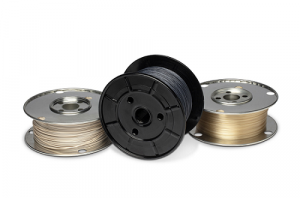 Global specialty polymer supplier Solvay was also at formnext this week to launch new products. The company introduced three new additions to its high-performance 3D printing filament portfolio – KetaSpire PEEK (NT1 HC), a 10% carbon fiber-reinforced KetaSpire (CF10 HC), and Radel PPSU (NT1 HC), which are Solvay’s first medical-grade materials for limited contact applications in the healthcare industry. The KetaSpire PEEK filaments enable high part density, achieve great printed layer fusion, and provide excellent part strength, along the z-axis in particular. Radel PPSU delivers the same exceptional fusion, and also has toughness, transparency, and high elongation. These three new grades are available immediately in both North America and Europe through Solvay’s e-commerce platform.
Global specialty polymer supplier Solvay was also at formnext this week to launch new products. The company introduced three new additions to its high-performance 3D printing filament portfolio – KetaSpire PEEK (NT1 HC), a 10% carbon fiber-reinforced KetaSpire (CF10 HC), and Radel PPSU (NT1 HC), which are Solvay’s first medical-grade materials for limited contact applications in the healthcare industry. The KetaSpire PEEK filaments enable high part density, achieve great printed layer fusion, and provide excellent part strength, along the z-axis in particular. Radel PPSU delivers the same exceptional fusion, and also has toughness, transparency, and high elongation. These three new grades are available immediately in both North America and Europe through Solvay’s e-commerce platform.
“The healthcare industry is quickly emerging as a leading market to benefit from AM technology which makes customized parts for single use or low volumes possible. However, there is still a very limited choice of high-performance filaments that meet the stringent regulatory requirements in healthcare and this is the gap we want to close with our new selection of medical grade products,” said Christophe Schramm, Additive Manufacturing Business Manager at Solvay’s Specialty Polymers global business unit.
VisctoTec Launches New Two-Component Print Head
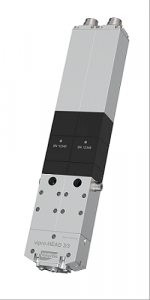 This spring, Germany-based ViscoTec, which is well known for its innovative 3D print heads, introduced the vipro-HEAD, a print head with an optional heating function for viscous fluids. The vipro-HEAD 3 and vipro-HEAD 5 allow the company’s 3D printing customers to process viscous fluids and pastes, and now ViscoTec has delivered again. At formnext this week, the company launched its new two-component print head, vipro-HEAD 3/3 and 5/5, which allows for the 3D printing of two-component viscous fluids and pastes.
This spring, Germany-based ViscoTec, which is well known for its innovative 3D print heads, introduced the vipro-HEAD, a print head with an optional heating function for viscous fluids. The vipro-HEAD 3 and vipro-HEAD 5 allow the company’s 3D printing customers to process viscous fluids and pastes, and now ViscoTec has delivered again. At formnext this week, the company launched its new two-component print head, vipro-HEAD 3/3 and 5/5, which allows for the 3D printing of two-component viscous fluids and pastes.
The print head, which comes in two sizes, has parallel, independently running motors, which receive direct signals from the 3D printer itself. Bleeding screws can be adapted to the vipro-HEAD 3/3 and 5/5 for venting during start-up, and optional integrated pressure sensors can monitor the output pressure at the static mixer, so dosing is automatically stopped if any pressure fluctuations occur so the rotor and stator aren’t damaged. With ViscoTec’s new print head, nearly all two-component viscous fluids and pastes can be dispensed continuously and gently.
Additive Industries and Air Liquide Announce Partnership
 The last piece of formnext 2018 news to share with you today is the newly announced partnership for industrial 3D printing between France-based Air Liquide and Netherlands company Additive Industries. The two have long enjoyed a working relationship, and decided to increase this into a professional partnership, in order to develop a dedicated infrastructure for gasses. Air Liquide will add its solutions for supplying and storing shielding gasses, and an infrastructure blueprint for Additive Industries’ MetalFAB1 3D printer will allow customers in demanding markets to increase the safety, quality, and post-processing of 3D printing.
The last piece of formnext 2018 news to share with you today is the newly announced partnership for industrial 3D printing between France-based Air Liquide and Netherlands company Additive Industries. The two have long enjoyed a working relationship, and decided to increase this into a professional partnership, in order to develop a dedicated infrastructure for gasses. Air Liquide will add its solutions for supplying and storing shielding gasses, and an infrastructure blueprint for Additive Industries’ MetalFAB1 3D printer will allow customers in demanding markets to increase the safety, quality, and post-processing of 3D printing.
“On our continuous quest to improve the performance of our systems while offering our users a fully integrated solution, we have identified the gas infrastructure for argon and nitrogen as an often overlooked but important piece of the puzzle,” said Daan Kersten, CEO of Additive Industries. “Because of our partnership with Air Liquide, we now can offer a blueprint to our customers to guarantee a reliable gas storage and supply as well as a higher level of safety, our number one priority.”
Topology Optimization Used by Honeywell FM&T Engineers
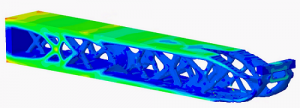 Honeywell FM&T, an engineering, manufacturing and sourcing enterprise that’s part of the aerospace company Honeywell, manages and operates the Kansas City National Security Campus for the US Department of Energy. It used to take the engineers months to design and produce materials to use for tooling and testing purposes. But Honeywell FM&T is now saving time by using digital manufacturing technology, which allows the engineers to bring their ideas to fruition in days, instead of months.
Honeywell FM&T, an engineering, manufacturing and sourcing enterprise that’s part of the aerospace company Honeywell, manages and operates the Kansas City National Security Campus for the US Department of Energy. It used to take the engineers months to design and produce materials to use for tooling and testing purposes. But Honeywell FM&T is now saving time by using digital manufacturing technology, which allows the engineers to bring their ideas to fruition in days, instead of months.
Topology optimization, or TO, shortens the normal design process by creating a prototype based on the functional and physical requirements, and then simulating production with it. 3D products designed with TO are less expensive, more lightweight, and stronger, and the Honeywell FM&T team recently used the technology to redesign a part that would meet structural requirements, but also weighs 46% less as well.
Discuss these stories and other 3D printing topics at 3DPrintBoard.com or share your thoughts in the Facebook comments below.


